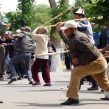
National Investigation of the Osh Violence Yields Little Results
Publication: Eurasia Daily Monitor Volume: 8 Issue: 18
By:

Seven months after the violence in Osh, much uncertainty prevails about what caused the bloodshed and who were its main perpetrators. Instead, rumors fill the gaps, with some in Kyrgyzstan fearing a renewal of violence and others quietly blaming either ethnic Uzbeks or ethnic Kyrgyz for instigating the conflict. On January 20, a special National Commission, composed of local experts, presented the initial findings of its investigation (www.akipress.kg, January 20). The commission, however, largely failed to reveal any important information about the violence on June 10-14, 2010.
According to the commission’s findings, 426 people died during the five-day violence in Osh, among them 276 ethnic Uzbeks and 105 ethnic Kyrgyz. The identities of the remainder are currently being indentified. The National Commission blames President Roza Otunbayeva’s government for its inability to prevent the violence. According to the commission’s Chairman, Abdygany Erkebayev, the government was aware of the risk of violence in Osh but ignored the threat. Erkebayev named specific officials that were responsible for preventing the outbreak of violence, including the former Deputy Chairman of the interim government, Azimbek Beknazarov, former acting Defense Minister, Ismail Isakov, former acting Interior Minister, Bolot Sher, former acting Chairman of the National Security, Keneshbek Dushebaev, as well as some members of the local government in Osh and Jalalabad (www.kloop.kg, January 11).
Kadyrzhan Batyrov, a well-known Uzbek entrepreneur, was again accused of involvement in the violence. Erkebayev assumes that Batyrov was actively promoting the idea of Uzbek autonomy by separating Osh from the rest of Kyrgyzstan. The commission’s chairman also alleged that Batyrov was possibly hoping that Uzbekistan would intervene in the conflict. However, the National Commission has tried to emphasize that no ethnic group should be blamed for instigating the violence.
In addition to these findings, Erkebayev referred to the involvement of abstract “third forces” and alleged that the former President, Kurmanbek Bakiyev, had played a role (www.24.kg, January 11). In effect, the commission’s latest findings have not added anything new to the existing various interpretations of the Osh violence. Its accusations against specific members of the government are unlikely to be investigated further by law-enforcement agencies in the near future. But it may be used for political purposes by competing parties at a later stage.
Erkebayev failed to specify what responsibilities government officials and police forces abrogated, during and after the June 10-14 conflict. According to one of the commission’s members, Nurbek Toktakunov, the leaders of the investigation showed a lack of understanding legal norms while accusing specific individuals of misconduct (www.precedent.kloop.kg, January 11). Toktakunov, himself a lawyer, refused to sign the commission’s final report. Instead, Toktakunov said the commission drew “superficial conclusions.”
Although the National Commission’s findings were largely disappointing, the investigation into the Osh violence continues. At least one more investigation is currently taking place, led by the Finnish Member of Parliament, Kimmo Kiljunen, who formed a group of international experts to act as objective outsiders.
According to the Kyrgyz human rights activist, Dmitry Kabak, both local and international investigations have their own flaws. “While local National Commission members often draw conclusions based on their historic bias of peoples living in southern Kyrgyzstan, international experts have been asking more superficial questions about the locals,” Kabak told Jamestown.
In the course of the ethnic violence 400,000 people were forced to flee from their homes. Uzbek communities are slowly reconstructing their homes, but peace remains fragile in Osh, with both the ethnic majority and minority groups in southern Kyrgyzstan blaming each other for instigating the fighting and infringing upon each other’s rights. Kiljunen group’s investigation findings, scheduled to be released within a few weeks, will also inevitably draw criticism. However, investigations continue, while the wider public is exposed to their various findings. Unlike the ethnic clashes in Osh in 1990, discussions are held in a more open environment. Each investigation might have its own shortcomings, but those are becoming part of a broader discourse among Kyrgyz human rights activists.
According to Jamestown sources, amid the ongoing tensions in southern Kyrgyzstan, both Uzbeks and Kyrgyz agree on at least two aspects. First, they blame Otunbayeva’s government for failing to stop the violence during the first day. Second, both groups believe that the real perpetrators of the violence have probably left the country.




